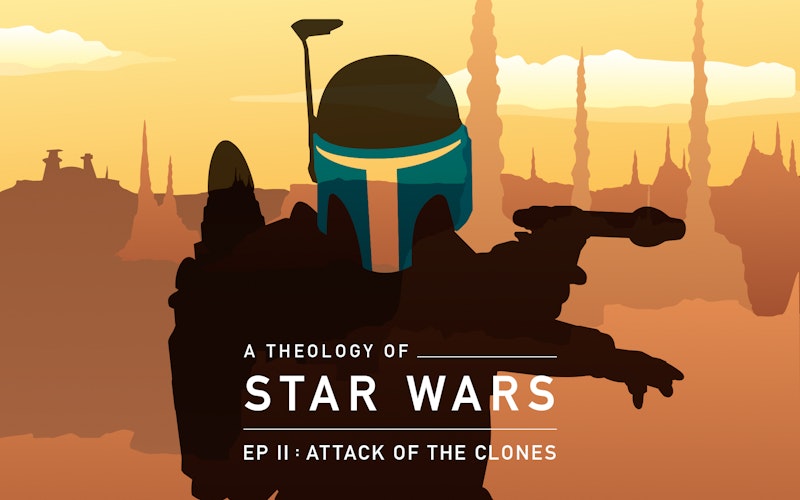
Movies
Star Wars: Episode II - He Who Lives by the Lightsaber…
Our Theology of Star Wars series also includes essays on Episode I, Episode III, Episode IV, Episode V and Episode VI. A free eBook version of the entire series is available here.
Pity the storyteller who – having sketched the faint outlines of a quasi-Buddhist guild that also once served as a sort of pan-galactic Ministry of Defense – subsequently resolves to depict in detail how such a thing could function at all. George Lucas never was a filmmaker to shrink from a challenge, though, and thus was begotten Star Wars: Episode II -Attack of the Clones.
In Clones, Lucas finally has the time and space to flesh out his Galactic Republic and the Jedi along with it. The resulting portrait of the Jedi is, if not the definitive depiction of the warrior monks, at least a logical depiction of them. Unfortunately, Lucas employs the dull logic of power, and it is an uneasy fit for the Jedi, whom we once knew and maybe loved, if only on a surface level.
It’s odd to learn that the quiet hermits-in-exile we knew from the original trilogy were once arguably draconian enforcers of a certain societal order. The Jedi are quick to go for their lightsabers in Attack of the Clones. While that’s not necessarily a bad thing in a space-adventure movie, it’s certainly unfortunate for a space-adventure series that spends much of its time setting up these figures as beneficent peacekeepers. In Clones, the Jedi are quick to pay lip service to their political neutrality and reluctance to fight, but they seem just as quick to engage in (to use Anakin Skywalker’s phrase) “negotiations with the lightsaber.” Individual violence is a tool to be deployed at one’s discretion. “Use the Force” means multiple things for these Jedi.
Questions surrounding the ethics of conflict have always bedeviled nonviolent religions, of course. As Christians, we are to eschew worldly power and embrace the power made perfect in weakness. Pacifist theologian Richard Hays writes that “the power of violence is the illusory power of the Beast. …In this symbolic world, wars and fightings are caused by divided and unholy desires within the individual.” For Hays, the task of the church is “to train disciples in the disciplines necessary to resist the seductions of violence.”
By this standard, Lucas’ Jedi Council utterly fails to guide its Padawans. Who could blame them, when the lightsaber – which may be the coolest instrument of death ever conceived by the cinema – is so incredibly seductive? The Jedi seem to have caught fanboy enthusiasm for their candy-colored weapons like a head cold. Obi-Wan Kenobi tells his hotheaded pupil Anakin that “this weapon is your life!” Even old masters are not immune; the confrontation between Yoda and Count Dooku reaches its apotheosis when they set the Force aside and start swinging their sabers.
Lucas recognizes that violence begets violence.
Unfortunately, this propensity toward violence creates an unresolvable tension at the film’s heart. Lucas has trained his audience to be thrilled by the lightsaber and the derring-do that it makes possible, but in doing so he betrays a certain attitude toward violence that is incompatible with the Jedi’s peace-loving ways. For a succinct summation of that attitude, look no further than Padme’s hilariously blasé response to Anakin’s confession that he’s slaughtered an entire village of Tusken Raiders: “To be angry is to be human, Anakin.” Oh well!
Natalie Portman’s performance as Padme is fascinating. Her facial expression and body language convey the shocked horror that is the natural reaction to such a confession, but those nonverbal cues don’t correspond with the bland platitudes leaving her mouth. This is a microcosm of the dissonance in the film’s treatment of violence: actions and words totally at odds with each other. The audience could be excused for drawing the conclusion that Anakin’s true sin is not the killing itself, but rather the fact that he killed out of anger, rather than dispassionately as his superiors in the Jedi Council do.
As for those older and wiser Jedi – what changed between the original trilogy and Attack of the Clones? The Obi-Wan who sacrificed his life in his duel with Vader now equates a lethal weapon with life itself. Yoda goes from scorning the battlefield entirely (“Wars make not one great”) to heroically commanding battlefield maneuvers (“Around the survivors a perimeter create!”). Is this just sloppy storytelling?
Of course not, for as we all know, this is not the chronology of the story. To understand the Jedi this way would be to get the progression backward.
There is a poignant moment in Clones’ coliseum battle scene that foreshadows the series’ evolving view of violence. One brief camera shot provides a second’s respite from all the spectacular fighting. The young Boba Fett crouches over his father’s head, which Jedi Master Mace Windu has recently severed from its body without even breaking a sweat. The child is shot in profile – almost in silhouette – as he picks up the head and presses it to his own forehead. It’s a striking image both of grief and of the momentous transmittal of a legacy of violence. The child will eventually put on his father’s mantle, and he will not forget how that mantle was passed on to him.
This moment suggests that Lucas understands the gravity of all the exciting lightsaber carnage he dishes up in Attack of the Clones. He recognizes that violence begets violence. The nonviolent Jedi of Lucas’ original trilogy do not mutate into the autocratic guardian-soldiers of the prequels, but instead age and change over time into the nonviolent sages we met in A New Hope. Perhaps the Jedi we first loved learned to rue violence and war only once they discovered what it was like to be on the losing end of the saber.
Topics: Movies, Culture At Large, Arts & Leisure